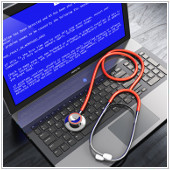Laptops are so convenient and hassle-free to use. It’s easy to forget that they need regular maintenance. One of the most common causes of laptop damage is overheating. Learn how to prevent your laptop from overheating, so you can boost its speed and prolong its life.
Causes of overheating
Laptops create heat during their normal operation. That’s why they’re designed with internal fans that blow out hot air and suck in cooler air. When your laptop keeps shutting down or suffers serious slowdowns, chances are it’s overheating.
One of the most common causes of overheating is when the fan doesn’t operate normally. This may be due to dust and grime clogging up the fan, preventing it from rotating properly. It’s also possible that the air vents are being blocked, preventing air from flowing into the laptop.
Another thing to consider is the age of your laptop’s battery, which relies on lithium to store electricity. This chemical naturally decays over time, no matter how carefully you use it. The older the battery, the less efficient it is and the more heat it generates.
Software use can also contribute to overheating. Too many apps and programs running in the background can overwork your laptop.
What to do if it’s overheating
The first thing you should do is check your hardware. Turn your laptop off and inspect the vents and your fan for any dirt, grime, or other possible causes of blockage. Also check whether the fan itself is not physically dented, which can slow down its rotation.
Sometimes overheating is simply caused by bad habits. Do you use your laptops in bed or on the carpet? Do you use pillows as padding? Uneven or soft surfaces often block the air vents, leading to overheating. Always place your laptop on a hard, even surface.
Aside from the hardware, check your software. Are there a lot of apps and programs that start automatically when you switch on your laptop? If yes, then you may need to limit them.
Keeping it cool
To prevent your laptop from overheating, always make sure that there’s adequate airflow for your laptop. Better yet, invest in a cooling pad. These pads lift your laptop and add more fans to facilitate better airflow.
Limit the number of programs that run when you start your laptop. Change your settings to “power save.” And shut down your laptop whenever you’re not using it.
It’s easy to take laptops for granted because they’re billed as plug-and-play devices. However, with a little extra care and attention, your devices will last much longer. If you want to prolong the lifetime of your IT hardware, call our experts today.

 So your computer just crashed. Our condolences. When your PC displays a blue screen and spontaneously restarts your computer, this is called the Blue Screen of Death (BSoD). These errors are usually caused by internal failures in your hardware or, sometimes, your software. That’s all well and good, but how can you troubleshoot these problems? Before taking any actions to fix your computer however, you’re going to have to do some detective work and pinpoint what part of your system caused the crash.
So your computer just crashed. Our condolences. When your PC displays a blue screen and spontaneously restarts your computer, this is called the Blue Screen of Death (BSoD). These errors are usually caused by internal failures in your hardware or, sometimes, your software. That’s all well and good, but how can you troubleshoot these problems? Before taking any actions to fix your computer however, you’re going to have to do some detective work and pinpoint what part of your system caused the crash.